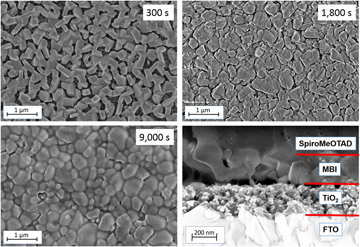Crossref Citations
This article has been cited by the following publications. This list is generated based on data provided by
Crossref.
Liu, Xia
Cao, Lianzhen
Guo, Zhen
Li, Yingde
Gao, Weibo
and
Zhou, Lianqun
2019.
A Review of Perovskite Photovoltaic Materials’ Synthesis and Applications via Chemical Vapor Deposition Method.
Materials,
Vol. 12,
Issue. 20,
p.
3304.
Sanders, S.
Stümmler, D.
Pfeiffer, P.
Ackermann, N.
Simkus, G.
Heuken, M.
Baumann, P. K.
Vescan, A.
and
Kalisch, H.
2019.
Chemical Vapor Deposition of Organic-Inorganic Bismuth-Based Perovskite Films for Solar Cell Application.
Scientific Reports,
Vol. 9,
Issue. 1,
Kapoor, Surbhi
Goel, Neetu
and
Singhal, Sonal
2020.
Visualizing the catalytic advancements in nickel ferrite via inclusion of bismuth for the removal of hazardous environmental pollutants.
Water and Environment Journal,
Vol. 34,
Issue. S1,
p.
728.
Vuong, Van‐Hoang
Pammi, S. V. N.
Pasupuleti, Kedhareswara Sairam
Hu, Weiguang
Tran, Van Dang
Jung, Jang Su
Kim, Moon‐Deock
Pecunia, Vincenzo
and
Yoon, Soon Gil
2021.
Engineering Chemical Vapor Deposition for Lead‐Free Perovskite‐Inspired MA3Bi2I9 Self‐Powered Photodetectors with High Performance and Stability.
Advanced Optical Materials,
Vol. 9,
Issue. 12,
Ünlü, Feray
Deo, Meenal
Mathur, Sanjay
Kirchartz, Thomas
and
Kulkarni, Ashish
2022.
Bismuth-based halide perovskite and perovskite-inspired light absorbing materials for photovoltaics.
Journal of Physics D: Applied Physics,
Vol. 55,
Issue. 11,
p.
113002.
He, Zhangwei
Gong, Yongshuai
and
Tan, Zhan'ao
2022.
Recent Advances in Bismuth‐Based Solar Cells: Fundamentals, Fabrication, and Optimization Strategies.
Advanced Sustainable Systems,
Vol. 6,
Issue. 6,
Wang, Mingyue
and
Carmalt, Claire J.
2022.
Film Fabrication of Perovskites and their Derivatives for Photovoltaic Applications via Chemical Vapor Deposition.
ACS Applied Energy Materials,
Vol. 5,
Issue. 5,
p.
5434.
Wu, Ming-Chung
Ho, Ching-Mei
Hsiao, Kai-Chi
Chen, Shih-Hsuan
Chang, Yin-Hsuan
and
Jao, Meng-Huan
2022.
Antisolvent Engineering to Enhance Photovoltaic Performance of Methylammonium Bismuth Iodide Solar Cells.
Nanomaterials,
Vol. 13,
Issue. 1,
p.
59.
Vuong, Van-Hoang
Pammi, S.V.N.
Ippili, Swathi
Jella, Venkatraju
Nguyen Thi, Trinh
Sairam Pasupuleti, Kedhareswara
Kim, Moon-Deock
Ji Jeong, Min
Jeong, Jong-Ryul
Sik Chang, Hyo
and
Yoon, Soon-Gil
2023.
Flexible, stable, and self-powered photodetectors embedded with chemical vapor deposited lead-free bismuth mixed halide perovskite films.
Chemical Engineering Journal,
Vol. 458,
Issue. ,
p.
141473.
Palanichamy, Pavithrakumar
Santhanam, Agilan
Natarajan, Muthukumarasamy
and
Velauthapillai, Dhayalan
2024.
One‐Step Synthesis of Lead‐Free and Hole Transport Layer‐Free Methylammonium Bismuth Chloride ((CH3NH3)3Bi2IxCl9−x)‐Based Perovskite Solar Cells.
Energy Technology,
Vol. 12,
Issue. 8,
Palanichamy, Pavithrakumar
Madurai Ramakrishnan, Venkatraman
Govindaraj, Rajesh
Santhanam, Agilan
and
Velauthapillai, Dhayalan
2024.
Nanostructured bismuth chloride based ((CH3NH3)3Bi2IxCl9-x) active layers for lead-free perovskite solar cells.
Zeitschrift für Physikalische Chemie,
Kumaresan, Saranya
Jayram, Naidu Dhanpal
Velayudam Devasena, Alagu muthu
Janarthanan, B.
Ayyar, Manikandan
Ramasamy, Senthilkumar
Rajendran, Saravanan
Mohanavel, Vinayagam
Santhamoorthy, M.
and
Santhoshkumar, S.
2025.
Precise synthesis and characterization of lead-free organic bismuth halide MA3Bi2IxCl9-x (x = 3) and FA3Bi2IxCl9-x (x = 3) perovskite towards photovoltaic applications.
Journal of Alloys and Compounds,
Vol. 1033,
Issue. ,
p.
181300.
Wang, Zitong
Lyu, Miaoqiang
Zhang, Bo Wei
Xiao, Mu
Zhang, Chengxi
Han, EQ
and
Wang, Lianzhou
2025.
Thermally Evaporated Metal Halide Perovskites and Their Analogues: Film Fabrication, Applications and Beyond.
Small Methods,
Vol. 9,
Issue. 2,
